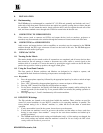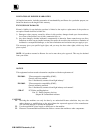
KRAMER Electronics, Ltd.
2
1. INTRODUCTION
Congratulations on your purchase of this Kramer Matrix switcher. Since 1981 Kramer has been
dedicated to the development and manufacture of high quality video/audio equipment. The Kramer
industrial line has become an integral part of many of the best video/audio production and presentation
facilities around the world. In recent years, Kramer has redesigned and upgraded most of the industrial
line, making the best even better. Kramer’s line of professional video electronics is one of the most
versatile and complete available, and is a true leader in terms of quality, workmanship,
price/performance ratio and innovation. In addition to the Kramer line of high quality video switchers,
such as the one you have just purchased, Kramer also offers a full line of high quality industrial and
broadcast distribution amplifiers, processors, interfaces, controllers and computer-related products.
Kramer welcomes your inquiries for Kramer equipment or custom-manufactured products,
engineering, private labeling and OEM manufacturing per your specifications. This manual includes
configuration, operation and accessory information for the VS-5x4.
1.1
A Word on Video/Audio Switchers
A video/audio switcher usually switches between several sources (inputs) and one or more acceptors
(outputs). A switcher that allows inputs to be connected to several outputs simultaneously is called a
Matrix Switcher. Switchers may be of the electronic or mechanical type. Most matrices are of the
active electronic type, with many crosspoints. Vertical Interval Switching, frequently used in video,
ensures that the transition from one video source to another (such as switching between two genlocked
cameras) is smooth and without interference. The switching and changeover is done during the blanked
vertical interval period, when the transition is hidden. Vertical Interval Switching is needed when
recording or transmitting a video program involving several video sources, as in live broadcast, to
ensure clean, undisturbed picture transitions. Matrices and switchers can be controlled by touch buttons
on the front panel, or by a PC, via the built-in RS-232 or RS-485/422 communication ports. Each of
these is a way of remotely controlling a video/audio device (switcher, SEG, etc.) using a PC with a
serial port, or another device that uses a similar communication protocol. Several machines can be
controlled from one PC. Its wide bandwidth permits this switcher to be used in the most demanding of
applications.
1.2
Factors Affecting Quality of Results
There are many factors affecting the quality of results when signals are transmitted from a source to
an acceptor:
Connection cables - Low quality cables are susceptible to interference; they degrade signal quality
due to poor matching and cause elevated noise levels. They should therefore be of the best quality.
Sockets and connectors of the sources and acceptors - So often ignored, they should be of highest
quality, since "Zero Ohm" connection resistance is the objective. Sockets and connectors also must
match the required impedance (75ohms in video). Cheap, low quality connectors tend to rust, thus
causing breaks in the signal path.
Amplifying circuitry - Must have quality performance when the desired end result is high linearity,
low distortion and low noise operation.
Distance between sources and acceptors - Plays a major role in the result. For long distances (over
15 meters) between sources and acceptors, special measures should be taken in order to avoid cable
losses. These include using higher quality cables or adding line amplifiers.
Interference from neighboring electrical appliances - These can have an adverse effect on signal
quality. Balanced audio lines are less prone to interference, but unbalanced audio and video lines
should be installed far from any mains power cables, electric motors, transmitters, etc. even when the
cables are shielded.


















